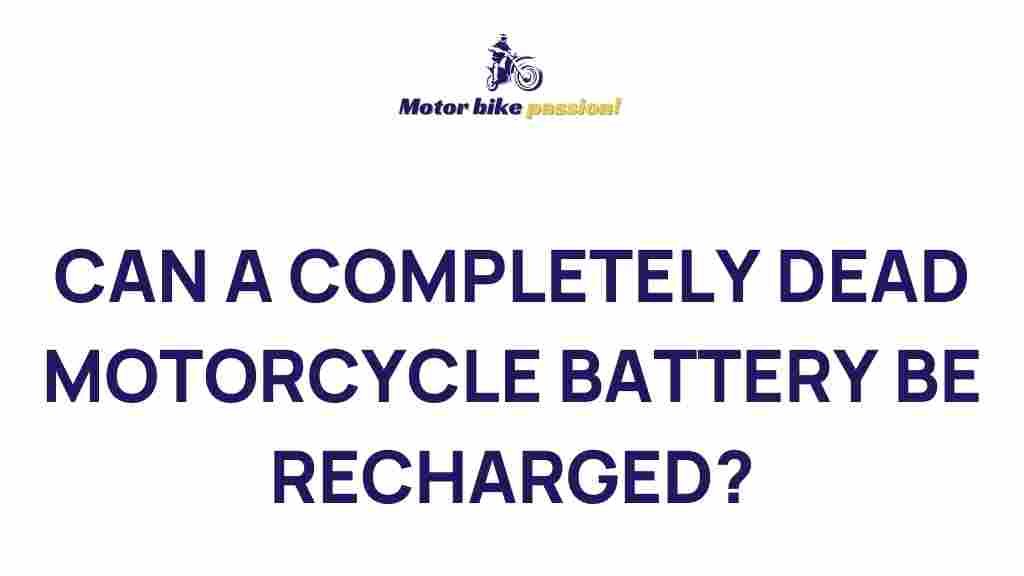Reviving a Completely Dead Motorcycle Battery
Owning a motorcycle comes with the responsibility of regular maintenance, and one of the most frustrating challenges is dealing with a completely dead motorcycle battery. Whether you left your bike idle for too long or the battery has simply aged, reviving it can save you time and money. In this guide, we’ll walk you through the process step-by-step, troubleshoot common issues, and help you get your motorcycle back on the road.
Understanding the Basics of Motorcycle Batteries
Before diving into the revival process, it’s essential to understand the types of batteries used in motorcycles. The most common ones include:
- Lead-acid batteries: Traditional and affordable, but require regular maintenance.
- AGM (Absorbent Glass Mat) batteries: More modern, sealed, and low-maintenance.
- Lithium-ion batteries: Lightweight, durable, and ideal for high-performance motorcycles.
Knowing your battery type helps you apply the correct revival method. If unsure, check your motorcycle’s manual or look for markings on the battery itself.
Steps to Revive a Dead Motorcycle Battery
1. Gather the Necessary Tools
Reviving a battery requires the right tools and a safe environment. Here’s what you’ll need:
- Protective gloves and goggles
- Battery charger (suitable for your battery type)
- Multimeter to test voltage
- Distilled water (for lead-acid batteries)
- Cleaning brush or cloth
2. Inspect the Battery
Remove the battery from the motorcycle, ensuring the ignition is off. Look for visible signs of damage like cracks or leaks. If the battery is physically damaged, it’s best to replace it.
Next, clean the terminals using a cleaning brush or cloth to remove dirt and corrosion. *Corroded terminals can impede the charging process, so ensure they’re spotless.*
3. Test the Voltage
Use a multimeter to measure the battery voltage. A healthy motorcycle battery typically reads between 12.6V and 12.8V when fully charged. If the reading is below 10.5V, the battery may be deeply discharged but still salvageable.
4. Begin Charging
Connect the battery to a charger. Here are key points to follow:
- Use a smart charger that adjusts current and voltage automatically.
- Set the charger to a low amp setting to prevent overheating.
- Charge the battery in a well-ventilated area to avoid gas buildup.
Charging times vary depending on the battery’s capacity and level of discharge. Monitor the process to ensure safety.
5. Check the Charge
Once the charger indicates the process is complete, test the battery voltage again. If it reads above 12.4V, the battery is ready to reinstall. If not, try a desulfation mode if your charger supports it, as this can help revive deeply discharged batteries.
Troubleshooting Common Issues
1. Battery Won’t Hold a Charge
If your motorcycle battery charges but quickly loses power, it might be sulfated or nearing the end of its life. Use a desulfator or consult a professional to assess whether it’s salvageable.
2. Charger Fails to Start
Some smart chargers won’t activate if the battery voltage is too low. In this case, jump-start the battery using another motorcycle battery or a car (ensure the car is off). This gives the dead battery enough initial voltage to begin charging.
3. Persistent Corrosion
Recurring corrosion can hinder performance. Apply a thin layer of petroleum jelly to the terminals after cleaning to prevent further buildup.
When to Replace Your Motorcycle Battery
Even with the best care, motorcycle batteries have a finite lifespan. If your battery is over 3-5 years old or fails to revive after multiple attempts, it’s time for a replacement. For guidance on choosing the right battery, check out our motorcycle battery selection guide.
Safety Tips and Precautions
- Always wear protective gear to prevent acid burns or injuries.
- Charge batteries in a well-ventilated area to avoid toxic gas buildup.
- Follow manufacturer guidelines for handling and maintenance.
Additional Resources
For further insights into motorcycle maintenance, explore this comprehensive motorcycle care guide. Staying informed ensures your bike stays in top condition.
Conclusion
Reviving a completely dead motorcycle battery might seem daunting, but with patience and the right steps, you can restore it to working condition. Regular maintenance and proper charging habits can prolong its life, saving you from unexpected breakdowns. Use this guide as a handy reference to tackle battery issues and keep your motorcycle running smoothly.
This article is in the category Basic Guides and created by MotorBikePassion Team

3 thoughts on “Reviving a Completely Dead Motorcycle Battery: A Beginner’s Guide”